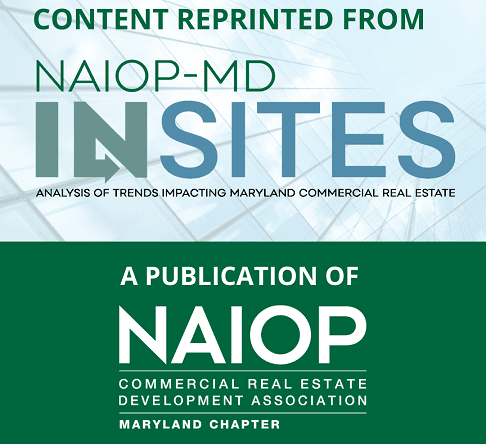 The Biden Administration’s $1.7 trillion proposal to repair the country’s aging infrastructure system takes aim on improving how Americans move around cities and towns, the speed of Internet connections, the quality and availability of energy and water and the enhancement of our nation’s educational institutions. If enacted, the plan is widely expected to significantly impact the Maryland economy with specific effects on the real estate sector.
The Biden Administration’s $1.7 trillion proposal to repair the country’s aging infrastructure system takes aim on improving how Americans move around cities and towns, the speed of Internet connections, the quality and availability of energy and water and the enhancement of our nation’s educational institutions. If enacted, the plan is widely expected to significantly impact the Maryland economy with specific effects on the real estate sector.
Dr. Stephen Fuller, University Professor Emeritus at George Mason University and founding director of The Stephen S. Fuller Institute and Seema Iyer, Associate Director, Jacob France Institute at the University of Baltimore offer their insights and perspectives concerning where these funds should be best applied.
Infrastructure upgrades key for Maryland to remain competitive

Dr. Stephen Fuller (SF): For Maryland to regain its competitive position in the mid-Atlantic economy, it is critical for the State to have a modern and efficient transportation system with capacity to support future growth. Impactful transportation improvements include adding lanes to the two beltways and replacing and widening the American Legion Bridge to alleviate traffic congestion and delays that increases the costs of doing business in Maryland. BWI has the largest passenger volume among the area’s three airports, but to remain competitive, further expansion is needed. Rail traffic is severely constrained by the Howard Street tunnel in Baltimore and its limited vertical clearance does not allow for double-decker freight cars — both are major issues. The Port of Baltimore needs expansion, a new Potomac crossing lining VA Route 28 to MD Route 200 and the Bay Bridge needs to be widened. I cannot emphasize the importance of expediting the flow of freight and truck traffic through our interstates. Investors gravitate to areas where transportation problems are less.

Seema Iyer (SI): Infrastructure represents the bones of economic development and, urban areas like Baltimore especially, need an injection of investment to support a thriving economy. We need a long-term and strategic vision for infrastructure planning. That wasn’t really part of the previous infrastructure investment that happened in response to the housing crash in 2008 which just tried to focus on “shovel-ready” projects. We need to build and increase access and mobility within many of our urban neighborhoods, without which has led to atrophy of some areas and the overall result is that Baltimore is now the only East Coast city that continues to lose population. As people migrate up and down the mid-Atlantic seaboard, they see robust and efficient transit systems effortlessly moving people around. This is not the case in Baltimore and poor flow in and out of neighborhoods and bottlenecks, particularly around Howard Street, remain major obstacles for growth. It is important to not only stay pace with Virginia, but leapfrog what they have to offer. For this to happen, we need to find ways to efficiently move people especially since commute times are growing everywhere to fuel an urban strategy to leapfrog into 21st century transit projects, which might include the resurrection of the Red Line.
SF: Searching for a better way to link Baltimore with D.C. has been talked about for more than 50 years and the MARC system just doesn’t do it. The Amtrak Acela train is really suited to serve New York to D.C. An improved rail corridor would help both metropolitan centers.
SI: To truly form one large work shed encompassing Baltimore and Washington, D.C. transit options have to exist for workers at all income levels and occupations. In the past, infrastructure investments have actually devastated urban areas or areas with high African-American community. I’m hopeful that the current package will reverse those trends.
Construction sector will be primary beneficiary
SF: Enhancements and additions to infrastructure network will have a profoundly positive and long-term impact on the construction sector. With a 10-year funding program, these construction outlays will have a ripple effect that will benefit the broad-based businesses that support the construction industry resulting in significant and widespread beneficial economic impacts across the State, affecting every aspect of commercial real estate. Additionally, transportation-dependent industries will particularly benefit including warehousing and distribution, wholesale trade, manufacturing and tourism. Professional and business services is Maryland’s largest industry sectors and its growth is dependent on access to a large workforce. This access depends on improved infrastructure that makes transportation more efficient be it roads or mass transit.
SI: We are on the cusp of a once-in-a-generation opportunity to not only improve our transportation infrastructure but also clean our water and air. All forms of real estate would benefit from better transit, but I see residential and particularly affordable housing benefitting most.
Affordable education, improved childcare and workforce development are key inclusions
SF: What makes this package different and particularly compelling is the prospect to improve broadband Internet access to underserved communities, as it is proven that this is needed to participate in today’s economy. Many high school graduates are unprepared for the workforce, so it is critical to provide funding for workforce development and encouraging students to pursue the next level of education.
SI: Women are having the hardest time returning to work because of lack of childcare, but in general ensuring workers have access to quality and affordable childcare should be a bi-partisan issue. Also, older housing stock and the inner-city suburbs need modernizing and the good news is the American Jobs Plan is taking a holistic approach to housing as infrastructure. The future of urban economies depends on it.
Copyright 2021, NAIOP Maryland. Reprinted with permission from NAIOP-MD InSites. www.naiopmd.org.












